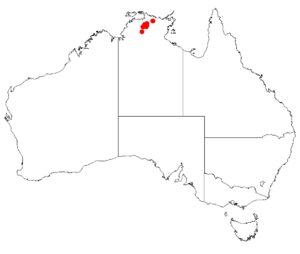Boronia xanthastrum facts for kids
Quick facts for kids Boronia xanthastrum |
|
|---|---|
| Conservation status | |
|
NT (TPWCA)
|
|
| Scientific classification | |
 |
|
| Occurrence data from Australasian Virtual Herbarium |
Boronia xanthastrum is a small, special shrub found only in the Northern Territory of Australia. It's known for its unique yellow, star-shaped hairs that cover its young branches, leaves, and parts of its flowers. This plant also has long, narrow leaves and small, yellowish-green flowers.
Contents
What is Boronia xanthastrum?
Boronia xanthastrum is a type of shrub that usually grows to about 40 cm (16 in) tall. It can live for just one year (called an annual plant) or sometimes for a few years (a short-lived perennial). Its branches, leaves, and parts of its flowers are covered with tiny, star-shaped yellow hairs. As the plant gets older, these hairs turn white.
The leaves of this plant are shaped like narrow ovals or spears. They are about 10–36 mm (0.39–1.42 in) long and 2.5–6.5 mm (0.098–0.256 in) wide. Each leaf sits on a short stalk called a petiole, which is about 0.5–1.5 mm (0.020–0.059 in) long.
Its Flowers and Fruit
The small, yellowish-green flowers grow either by themselves or in small groups of up to three. They appear where the leaves meet the stem. Each flower grows on a tiny stalk called a peduncle, which is about 0.5–1 mm (0.020–0.039 in) long.
Around the flowers, there are small, leaf-like parts called prophylls, which are about 1.5–4 mm (0.059–0.157 in) long. The outer parts of the flower, called sepals, are egg-shaped or triangular and are hairy on the outside. They are about 3.5–6 mm (0.14–0.24 in) long. The actual flower petals are yellowish-green, about 2.5–4 mm (0.098–0.157 in) long, and hairy on their top surface.
After the flowers bloom, the sepals grow bigger as the fruit starts to form. The petals, however, do not get bigger. Boronia xanthastrum flowers mostly between January and June. Its fruit is a smooth, dry seed pod called a capsule, which is about 4–6 mm (0.16–0.24 in) long and 2 mm (0.079 in) wide.
How it Got its Name
Boronia xanthastrum was first officially described in 1997 by a scientist named Marco F. Duretto. He wrote about it in a science journal called Australian Systematic Botany. The plant was found by Lyndley Craven near Twin Falls in 1980.
The second part of its name, xanthastrum (which is called the specific epithet), comes from ancient Greek words. "Xanthos" means "yellow," and "astron" means "star." This name perfectly describes the yellow, star-shaped hairs that make this plant look yellow.
Where it Lives
This special boronia plant grows in areas with rocks like schist and sandstone. It can be found in open woodlands and heathlands. Most of these plants live in Kakadu National Park. You can also find them in Nitmiluk National Park and in some separate areas (called disjunctly) in the north-east part of Arnhem Land.
Is it Protected?
This plant is currently listed as "near threatened" under the Territory Parks and Wildlife Conservation Act 2000. This means it's a species that could become threatened if we don't protect its habitat. Before this, it was considered "vulnerable" under a different law, the Australian Government Environment Protection and Biodiversity Conservation Act 1999.

